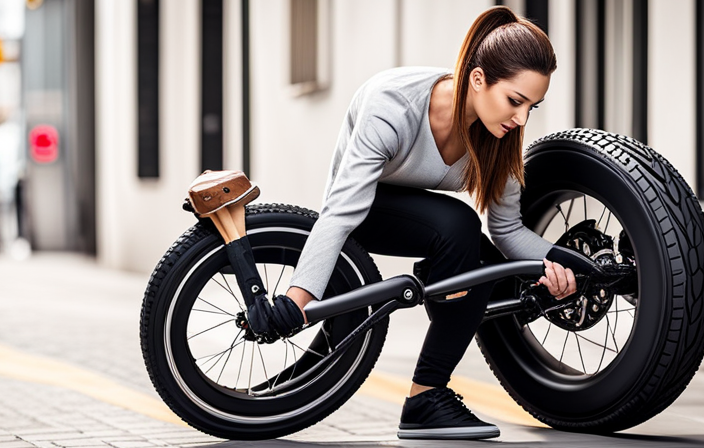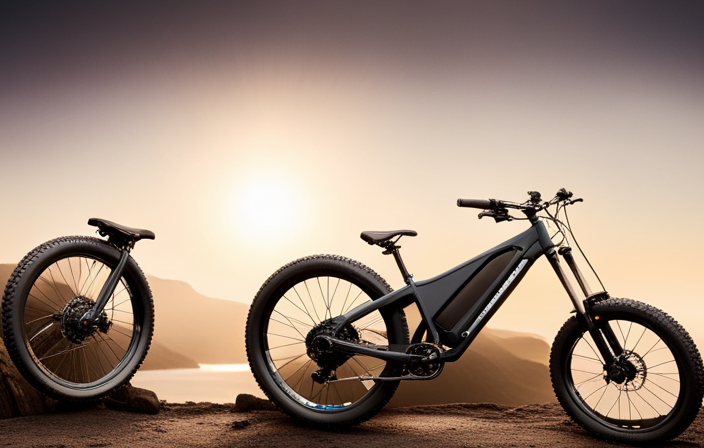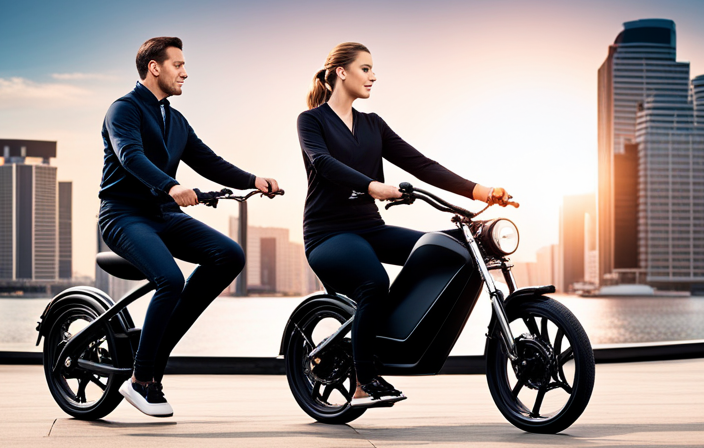Are you ready to take your electric bike to the next level?
In this detailed guide, we will show you how to build a 36v 20ah LiFePO4 battery, giving your bike a portable power source that will revolutionize your rides.
From understanding the intricacies of LiFePO4 batteries to gathering the necessary tools and materials, we will guide you through each step with precision.
Get ready to experience long-lasting power and exhilarating rides like never before!
Key Takeaways
- Check the battery for damage or leakage
- Use appropriate charging equipment and follow instructions
- Regularly inspect the battery for damage or corrosion
- Store the battery in a cool and dry place when not in use
Understanding LiFePO4 Batteries
LiFePO4 batteries are known for their high energy density and long cycle life. These batteries have several advantages over other types of batteries, making them a popular choice for various applications.
One key advantage of LiFePO4 batteries is their high energy density, which allows for more power to be stored in a smaller and lighter battery pack. This makes them ideal for electric bike portable batteries, as they provide a longer range without adding excessive weight.
Additionally, LiFePO4 batteries have a longer cycle life compared to other types of batteries. This means they can endure more charge and discharge cycles before their capacity starts to degrade.
With their reliable performance and high capacity, LiFePO4 batteries are the perfect choice for building a 36V 20Ah electric bike portable battery.
To get started, let’s gather the necessary tools and materials.
Gathering the Necessary Tools and Materials
First, you’ll need to gather all the necessary tools and materials for your 36v 20ah battery assembly. Here’s a detailed list of what you’ll need:
-
Tools:
-
Soldering iron
-
Wire cutters
-
Heat shrink tubing
-
Multimeter
-
Materials:
-
LiFePO4 battery cells
-
Battery management system (BMS)
-
Battery enclosure
-
Cell connectors (make sure to select appropriate ones)
-
Nickel strip
-
Insulating paper
-
Battery terminal connectors
-
Ventilation fan
When selecting cell connectors, it’s crucial to choose ones that can handle the high current flow of your battery. Ensure proper ventilation by adding a ventilation fan to your battery enclosure. This will prevent overheating and prolong the lifespan of your battery.
Now that you have gathered all the necessary tools and materials, let’s move on to the next section about choosing the right battery cells.
Choosing the Right Battery Cells
Now that you have gathered all the necessary tools and materials, it’s important to choose the right battery cells for your assembly. The battery cell selection is a crucial step in building your 36V 20Ah LiFePO4 battery for your electric bike. When choosing battery cells, you need to consider their capacity, which refers to the amount of energy they can store. Higher capacity cells will allow your battery to provide more power and have a longer range. To help you make an informed decision, consider the following table that compares different battery cell options based on their capacity:
| Battery Cell | Capacity (Ah) |
|---|---|
| Cell A | 10 |
| Cell B | 15 |
| Cell C | 20 |
| Cell D | 25 |
| Cell E | 30 |
By selecting the appropriate battery cell capacity, you can ensure that your electric bike’s portable battery will meet your power requirements. Now, let’s move on to the next step of building the battery pack.
Building the Battery Pack
To assemble the battery pack, you’ll need to carefully connect the chosen battery cells in a series or parallel configuration. Battery pack construction requires attention to detail and precision. Here’s a step-by-step guide to help you with the battery pack assembly:
-
Gather all the necessary materials, including the battery cells, nickel strips, spot welder, and insulating materials.
-
Determine the desired voltage and capacity for your battery pack and arrange the cells accordingly.
-
Connect the cells in series or parallel configuration, ensuring the positive and negative terminals are correctly aligned.
-
Use nickel strips to connect the cells together, ensuring a secure and reliable connection.
-
Insulate the battery pack using appropriate materials to prevent short circuits and ensure safety.
Once the battery pack is constructed, the next step is wiring and connecting the cells.
Wiring and Connecting the Cells
After assembling the battery pack, the next step is to wire and connect the cells together.
To ensure a reliable and efficient battery system, it’s crucial to use proper wiring techniques and cell connection methods.
Start by soldering nickel strips to the positive and negative terminals of each cell. These strips will serve as the electrical connections between the cells.
Make sure to arrange the cells in series or parallel configuration, depending on your desired voltage and capacity.
Use copper busbars to connect the nickel strips of each cell together. This will create a solid and secure electrical connection.
It’s important to double-check all the connections to avoid any short circuits or loose connections.
Once the cells are properly wired and connected, you can proceed to add a battery management system for enhanced safety and performance.
Adding a Battery Management System
To ensure the safety and performance of your battery system, you should consider adding a battery management system (BMS) during the battery management system installation process.
A BMS is a crucial component that monitors and controls the battery’s voltage, current, and temperature. It helps prevent overcharging, over-discharging, and overheating, which can damage the battery and reduce its lifespan.
Additionally, a BMS provides balance charging, ensuring that each individual cell is charged to the same level, thus optimizing the battery’s capacity and longevity.
By using a battery management system, you can extend the overall lifespan of your battery pack and improve its efficiency.
Now, let’s move on to the next step of designing the battery enclosure.
Designing the Battery Enclosure
First, consider the size and shape of your battery enclosure to ensure it fits securely and efficiently within your desired application. The battery enclosure design is crucial for protecting your battery from external elements and providing structural support.
You’ll need to choose a material that is durable, lightweight, and resistant to impact. Additionally, consider implementing waterproofing techniques to safeguard the battery from moisture and rain. This can include using gaskets, seals, or even waterproof coatings.
Remember to account for ventilation to prevent overheating. Once you have designed the battery enclosure, you can proceed to the next step of installing the battery onto your electric bike, ensuring a seamless integration and maximum functionality.
Installing the Battery onto Your Electric Bike
Make sure you securely attach the battery to your e-bike frame, ensuring a stable and reliable connection. There are various installing techniques and battery placement options to consider.
One option is to use Velcro straps to secure the battery onto the frame, providing a quick and easy attachment. Another option is to use mounting brackets specifically designed for e-bike batteries, which offer a more permanent and secure solution.
When installing the battery, make sure it is positioned in a way that does not interfere with the bike’s center of gravity or affect the overall balance. It is also important to consider the accessibility of the battery for future maintenance and charging.
Once the battery is securely installed, you can move on to testing and charging the battery, ensuring it is ready for your electric bike adventures.
Testing and Charging the Battery
Now that you have successfully installed the battery onto your electric bike, it’s time to move on to the next step: testing and charging the battery.
To ensure that your battery is functioning properly, you need to employ effective testing techniques. This includes checking the voltage levels using a multimeter and verifying that there are no loose connections or damaged wires.
Once you have confirmed that the battery is in good condition, it’s time to charge it. You will need the appropriate charging equipment, such as a 36V charger specifically designed for LiFePO4 batteries. Make sure to follow the manufacturer’s instructions and use the correct charging settings to avoid any damage to the battery.
Once the battery is fully charged, you can proceed to the next section, which focuses on ensuring safety measures are in place.
Ensuring Safety Measures
To ensure safe operation, it is important to follow proper safety measures when using and maintaining the battery for your electric bike.
Safety precautions are necessary due to the handling of hazardous materials. First and foremost, always wear protective gloves and goggles when working with the battery. Avoid any direct contact with the battery terminals to prevent electrical shock.
Additionally, ensure that the battery is stored in a cool and dry place, away from flammable materials. When charging the battery, use only the recommended charger and follow the manufacturer’s instructions. It is crucial to never overcharge the battery to prevent overheating and potential damage.
Lastly, regularly inspect the battery for any signs of damage or leakage and replace it immediately if needed. By taking these safety measures, you can ensure the longevity and reliable performance of your battery.
Moving on to maintaining and caring for your battery, it is essential to…
Maintaining and Caring for Your Battery
Maintaining and caring for your battery is crucial for ensuring its longevity and reliable performance. Proper battery maintenance and care can significantly extend the lifespan of your battery and maximize its efficiency.
To start, it is essential to keep your battery clean and free from dirt, dust, and moisture. Regularly inspect the battery for any signs of damage or corrosion and address them promptly.
Additionally, make sure to charge your battery using the appropriate charger and avoid overcharging or deep discharging, as it can degrade the battery’s capacity over time. It is also recommended to store your battery in a cool and dry place when not in use.
By following these battery maintenance and care practices, you can ensure that your battery remains in optimal condition and continues to deliver reliable power for your electric bike.
Transitioning into the next section, let’s explore how you can further extend the lifespan of your battery.
Extending the Lifespan of Your Battery
To extend the lifespan of your battery, it’s important to avoid fully discharging it on a regular basis. Fully discharging a battery can cause irreversible damage and significantly reduce its overall lifespan.
Instead, try to keep your battery charged between 20% and 80% capacity. This range allows for optimal performance while minimizing the stress on the battery cells.
Additionally, it’s important to regularly perform battery maintenance techniques to ensure longevity. This includes keeping the battery clean and dry, avoiding extreme temperatures, and storing it in a cool and well-ventilated area when not in use.
By following these guidelines and taking proper care of your battery, you can maximize its lifespan and overall performance.
Now, let’s move on to troubleshooting common issues…
Troubleshooting Common Issues
Troubleshooting common issues with your battery can help identify and resolve any problems that may be affecting its performance. When troubleshooting battery issues, it is important to start by checking for any physical damage or loose connections. Make sure that all the connections are secure and free from corrosion. If the battery is not charging properly, there could be a problem with the charger or the charging port. Test the charger with a different battery to determine if it is the source of the issue. Additionally, check the charging port for any debris or damage that may be preventing a proper connection. If you are still experiencing problems, it may be necessary to consult a professional for further assistance. By troubleshooting charging problems, you can ensure that your battery is functioning optimally and maximize its lifespan. In the next section, we will explore additional battery upgrades that can enhance your electric bike’s performance.
Exploring Additional Battery Upgrades
If you’re looking to improve your electric bike’s performance, consider exploring additional upgrades for your battery.
Upgrading your battery can greatly enhance its performance and optimize efficiency. One way to improve battery performance is by increasing its capacity. A higher capacity battery, such as a 36V 20Ah LiFePO4 battery, will allow you to enjoy longer rides without worrying about running out of power.
Another option is to upgrade to a battery with a higher voltage, such as a 48V battery. This can provide more power and torque, allowing for faster acceleration and better hill climbing capabilities.
Additionally, you can consider upgrading to a battery with a higher discharge rate, which can improve the overall performance of your electric bike.
By exploring these battery upgrades, you can enjoy long and powerful rides without compromising on battery performance.
Enjoying Long and Powerful Rides
Experience the thrill of long and powerful rides with upgraded battery performance.
When it comes to maximizing battery efficiency for long distance electric bike rides, there are a few tips to keep in mind.
First, make sure to fully charge your 36v 20ah LiFePO4 battery before embarking on your journey. This will ensure that you have the maximum amount of power available.
Additionally, try to maintain a steady and consistent pace throughout your ride, as frequent acceleration and deceleration can drain your battery faster.
Another tip is to avoid excessive use of power-hungry features, such as high-powered lights or a throttle assist. By using these features sparingly, you can conserve energy and extend your battery life.
Finally, consider investing in a battery management system, as it can help monitor and optimize battery performance.
With these tips, you can enjoy long and powerful rides on your electric bike portable battery.
Frequently Asked Questions
Can I use a different type of battery cells instead of LiFePO4 for my electric bike?
Yes, you have alternative battery options for your electric bike instead of using LiFePO4 cells. Different battery cells, such as lithium-ion (Li-ion) or nickel-metal hydride (NiMH), can be used.
Li-ion offers high energy density and lightweight design, while NiMH provides good energy efficiency and reliability. However, the choice depends on your specific requirements for capacity, weight, cost, and lifespan.
It is recommended to consider the pros and cons of each option before making a decision.
How can I increase the voltage of my battery pack?
To increase the voltage of your battery pack, you need to carefully select the right battery cells. Choosing cells with a higher nominal voltage will allow you to achieve the desired increase.
However, it is crucial to consider other factors such as compatibility with your electric bike and the overall capacity of the battery. Additionally, ensure that the cells you choose can handle the increased voltage without compromising safety or performance.
Is it possible to use a battery management system from a different brand?
Using a battery management system (BMS) from a different brand may result in compatibility issues. Different brands may have varying communication protocols, connectors, and voltage ranges, making it challenging to integrate them seamlessly.
This can lead to improper monitoring and protection of the battery pack. Additionally, the performance of the electric bike battery may be affected as the BMS may not accurately balance the cells, resulting in reduced overall capacity and potential safety risks.
Careful consideration and thorough testing are crucial when using a different brand’s BMS.
What are the safety precautions I should take while building the battery pack?
To ensure safety while building a battery pack, it’s crucial to follow certain guidelines.
Firstly, always wear protective gear like gloves and safety glasses.
Secondly, properly insulate all wiring connections to prevent short circuits.
Additionally, use a battery management system from the same brand to ensure compatibility and optimal performance.
One interesting statistic is that improper insulation of battery connections accounts for 20% of battery-related accidents.
By adhering to safety precautions, you can greatly reduce the risk of accidents and ensure a safe battery pack assembly.
Can I connect multiple battery packs in parallel to increase the capacity of my electric bike battery?
Yes, you can connect multiple battery packs in parallel to increase the capacity of your electric bike battery. By connecting batteries in parallel, you are essentially combining their capacities, allowing for longer rides on a single charge. This setup also provides increased power output capability.
However, there are some considerations. Parallel connections require careful matching of battery capacities and voltages to ensure balanced charging and discharging. Additionally, the overall size and weight of the battery pack will increase with each added parallel pack.
Conclusion
Congratulations on successfully building your 36V 20Ah LiFePO4 battery for your electric bike! By following the step-by-step guide and investing time in understanding LiFePO4 batteries, you have created a portable power source that will enhance your cycling experience.
Did you know that LiFePO4 batteries have an impressive lifespan of up to 2000 cycles? This means you can enjoy long and powerful rides for years to come, without worrying about frequent replacements.
So, gear up and get ready to embark on exciting adventures with your reliable and high-performance electric bike battery!
















